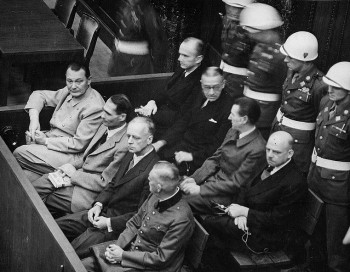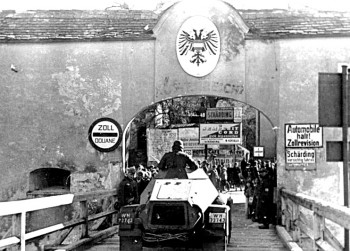Note: This novel was WINNER of the 2017 Prix Goncourt, France’s most prestigious prize.
“The sun is a cold star. Its heart, spines of ice. Its light, unforgiving. In February, the trees are dead, the river petrified…Time stands still. In the morning, not a sound, not even birdsong. Then an automobile, and another, and suddenly footsteps, unseen silhouettes….Through doors obsequiously held open, [the shadows] step from their huge black sedans and parade in single file…and enter the large vestibule of the palace of the President of the Assembly.” – Berlin, February 20, 1933.
 Eric Vuillard’s latest prizewinner opens with the secret arrival of twenty-four wealthy industrialists at the Berlin palace of the President of the Assembly in 1933. Bearing names like Krupp, Opel, Siemens, and Vogler, these gentlemen have answered the call of Hermann Goering on behalf of Adolph Hitler and the Nazis to “help put an end to a weak regime, ward off the communist menace, eliminate trade unions, and allow every entrepreneur to be the fuhrer of his own shop.” Elections are coming in two weeks, and the Nazi Party has no money to spend to promote their position. “Time to pony up, gentlemen” is the appeal. In an unprecedented compromise with the Nazis, “Most of the guests immediately hand over hundreds of thousands of marks, Gustav Krupp gives a million, Georg von Schnitzler four hundred thousand, and so they rake in a hefty sum.”
Eric Vuillard’s latest prizewinner opens with the secret arrival of twenty-four wealthy industrialists at the Berlin palace of the President of the Assembly in 1933. Bearing names like Krupp, Opel, Siemens, and Vogler, these gentlemen have answered the call of Hermann Goering on behalf of Adolph Hitler and the Nazis to “help put an end to a weak regime, ward off the communist menace, eliminate trade unions, and allow every entrepreneur to be the fuhrer of his own shop.” Elections are coming in two weeks, and the Nazi Party has no money to spend to promote their position. “Time to pony up, gentlemen” is the appeal. In an unprecedented compromise with the Nazis, “Most of the guests immediately hand over hundreds of thousands of marks, Gustav Krupp gives a million, Georg von Schnitzler four hundred thousand, and so they rake in a hefty sum.”
Four years later, in November, 1937, the elections are long over, Germany is unified under its Nazi goals, and the regime’s only real threat is from foreign powers. The Saarland has been annexed, the Rhineland has been remilitarized, Guernica has been bombed, the Reichstag has been made defunct, and the Nazis “have abandoned all self-restraint.” When Lord Halifax is sent as an envoy from England to Berlin to meet with Hermann Goering in 1937, the author expresses his conviction that Lord Halifax had to have been fully aware of the dangers Hitler represented to the rest of Europe and cognizant of Goering’s mental instability: his sinister allusions, his morphine addiction, his raving egomania, his diagnoses of psychological disorder and depression, and his violent, sometimes suicidal, tendencies. The author, however, also points out the cruel limitations in Lord Halifax’s own makeup. His direct ancestors opposed aiding the Irish during the potato famine that left a million dead, and Halifax himself has stated publicly that “Racialism is a powerful force…neither unnatural nor immoral.” The author believes that Halifax’s callousness is “the result of social blindness and arrogance,” yet it is Halifax who is the British envoy sent to deal with the Nazis as they plan to invade Austria.
In February, 1938, Kurt von Schuschnigg, Chancellor of Austria, is called to Berlin to meet with Adolph Hitler. Here author Vuillard focuses on the interplay between the two men, stressing a “childish outburst” in which the Fuhrer announces proudly that he plans to build “the largest bridge in the world,” and then put up “the tallest buildings in the world,” and eventually build “much bigger and better houses than in the United States.” As Hitler declares his intentions to conjoin Germany and Austria politically on the national level, he also abandons all pretense, clearly illustrating that there is “only one art of persuasion, only one means of getting what you want: fear – [and] in this house fear was what prevailed.” After two hours of discussion and the inclusion of Germany’s Ribbentrop and von Papen in the conversation, Germany announces its own terms of “agreement” between it and Austria. Germany will impose the National Socialist doctrine on all of Austria, and control all aspects of the government through the appointment of Austrian sympathizers and the replacement of Austrian propaganda ministers with German ones. Its recognition of Austria’s sovereignty and independence are purely decorative. As preparations for the Blitzkrieg get underway, there is virtually nothing von Schuschnigg can do to stop it.
Throughout this work, author Vuillard stresses the games played by officials on both sides, the bluffs, the extreme positions, and the lies designed to sway populations. As the Germans begin their invasion of Austria, they quickly become aware that the tanks and other war materiel they plan to display throughout the march from the German border to Vienna are inoperable, broken. They simply pack everything up, put it on trains, and send it through the Austrian countryside by rail. Its appearance alone is enough to scare the population into submission. Having described in detail the means and methods by which the Nazis took over both the German population and the population of Austria and elsewhere, the author says little about the war itself, focusing instead on the Nuremberg trials after the war to show more details about propaganda methods, how they were imposed, and the excuses which war criminals offered, if any, in defense of their crimes.

The Nuremberg Trials began on November 20, 1945. In this picture, the man on the farthest left is Hermann Goering. Convicted and sentenced to death, he committed suicide the night before the hanging was to be carried out.
Author Vuillard compresses many years of wartime study into a novella-length book which shows how Hitler, an ordinary person with an unalterable goal, could affect the lives of so many other ordinary people through persuasion, fear, and raw power. By also incorporating some cultural elements into the book, such as the music of Beethoven, Bruckner, Haydn, Lizst, and Mozart, and the work of an artist, Louis Soutter, Vuillard incorporates surprising details which expand his themes and make them more inclusive. His stylistic excellence – from nearly romantic descriptions to hard reality – allows him to keep his focus literary, and to explore images of light and dark, warmth and cold, and the passage of time, while also expressing his conviction that “We never fall twice into the same abyss. But we always fall the same way, in a mixture of ridicule and dread.” Guilt, innocence, and ignorance get the full treatment here as Eric Vuillard brings life to the years leading up to the Second World War, and readers will be astonished by the breadth and depth of history which this author achieves within this very compressed work.
Photos. The author photo appears on https://www.practicaespanol.com/
The Time magazine cover is from http://content.time.com/
Germany’s entrance into Austria is shown on http://content.time.com
The Nuremberg Trials, showing Hermann Goering at the farthest left in this photo, are described and illustrated here: https://www.boerner.net/



